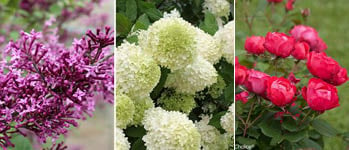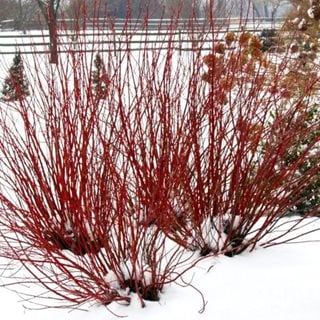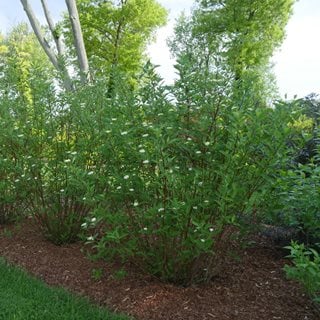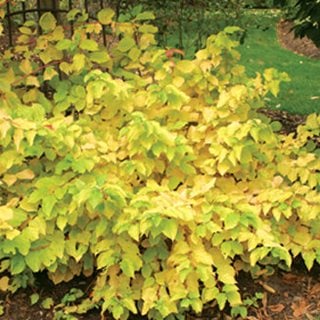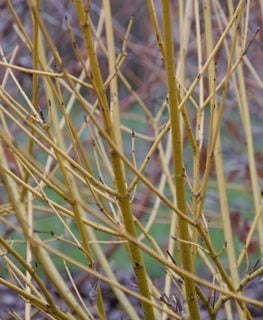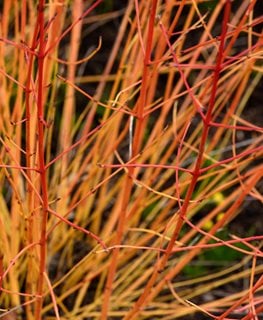How to Grow & Care for Red Twig Dogwoods
Grow this hardy easy-care shrub for year-round color Published 10/20/2022Red twig dogwood is grown primarily for the bright stems that add winter color to the landscape. Unlike the more commonly known flowering dogwood trees, this type is a shrub. Red twig dogwood is exceptionally hardy and long-lived, with four-season interest. In spring, the colorful stems give way to new foliage and flowers, which are followed by berries in summer and fall. Some varieties also have vibrant fall foliage.
There are several species that go by the common name of red twig dogwood, though some varieties produce stems in other colors, which can cause some confusion. Find out more about caring for this versatile shrub, and how to use it in your landscape.
On this page: Basics | Types | Planting | Care | Varieties | Landscaping Ideas
- BASICS
- TYPES OF RED TWIG DOGWOODS
- HOW TO PLANT RED TWIG DOGWOODS
- RED TWIG DOGWOOD CARE
- RED TWIG DOGWOOD VARIETIES
- LANDSCAPING IDEAS
BASICS
Botanical name:
Cornus spp.
Zones:
2-8, depending on the species
Plant type and growth rate:
Red twig dogwood is a deciduous shrub that produces multiple upright stems. Plants spread through suckering to form a dense thicket, with a rapid growth rate up to two feet per year.
Exposure:
Full sun to partial shade. Stem color is brightest in full sun.
Habit:
Upright spreading habit
Size:
2 to 15 feet tall and wide
Bloom time:
Late spring
Color:
Stem color occurs in hues of red, orange, yellow, chartreuse, coral, or purple, becoming more vivid in winter. Flat clusters of white four-petaled flowers appear in late spring to early summer, followed by clusters of pea-sized white, pale blue, or dark purple berries from summer to fall. Oval foliage is green, gold, or variegated, with some varieties producing yellow, red, or purple fall color.
Benefits:
Flowers are attractive to butterflies, bees, and other insect pollinators. The berries are a food source for songbirds and other wildlife, while the dense growth habit provides cover and nesting habitat for birds and small mammals.
Is red twig dogwood poisonous?
While the red twig dogwood plant is not considered toxic to pets or children, the berries are, so best to protect pets and children.
Is red twig dogwood deer resistant?
Red twig dogwood is considered deer resistant, though grazing may occur if other food sources are scarce.
TYPES OF RED TWIG DOGWOODS
There are three primary types of red twig dogwood:
- Tatarian dogwood (Cornus alba), also known as Siberian dogwood, is an Asian species with a native range from Siberia to the Korean peninsula. This medium-sized shrub grows rapidly, reaching 8 to 10 feet tall and wide. Plants have red stems, white flowers, green, gold, or variegated foliage, white or pale blue berries, and orange-red fall color. Hardy in USDA zones 2-7.
- Bloodtwig dogwood (Cornus sanguinea), also known as common dogwood, is native to Europe and western Asia. Named for the brilliant stems and deep crimson fall color, this larger species can reach 8 to 15 feet tall and wide. Stem color is variable, from red to gray-green, while the foliage is green. White flowers are followed by dark purple berries. Hardy in USDA zones 4-7.
- Osier dogwood (Cornus sericea, syn. C. stolonifera), native to North America, is typically found near swamps, wetlands, lakes and rivers. In its native habitat, plants can reach 6 to 9 feet tall and wide, though there are smaller varieties in cultivation. Plants have red or yellow stems, white or purple berries, green or variegated foliage and orange-red fall color. Hardy in USDA zones 2-8.
HOW TO PLANT RED TWIG DOGWOOD
When to plant:
Plant red twig dogwood during cooler months in spring or fall to avoid transplant shock from extreme summer heat.
Where to plant:
Red twig dogwood is tolerant of a wide range of soil and light conditions. Plants can tolerate wet soil as well as some drought. Plant in a location that receives full sun to partial shade with well-amended soil. Siting in more shade will help keep plants in check, though the stem coloring won’t be as vivid. When possible, place where the winter color can be enjoyed from inside your home.
How to plant:
Loosen soil in the planting area and amend with compost or other rich organic matter. Dig a hole twice as wide and slightly shallower than the depth of the root ball. Remove plant from the nursery container and loosen roots if potbound. Place in the hole so the top of the root ball is slightly higher than the surrounding soil. Fill in the hole with soil, tamp down gently to remove air pockets, and water thoroughly. Water regularly until established.
RED TWIG DOGWOOD CARE
Pruning and deadheading:
Every 1 to 3 years in late winter or early spring, up to a third of the oldest stems can be removed to stimulate growth of new stems, which produce the best coloring. Remove any dead or diseased growth. As an alternative to this pruning method, or to rejuvenate overgrown plants, all stems can be cut back to the ground in early spring every 2 to 3 years. This will likely result in the loss of flowers and berries for the current growing season. To control spread, remove root suckers around the outer base of the plant with a sharp spade.
Soil:
Red twig dogwood prefers rich well drained soil, with a slightly acidic pH between 5.5 to 6.5. Plants are tolerant of a wide range of soils.
Amendments and fertilizer:
Red twig dogwood needs little or no supplemental fertilizer. In early spring, side dress with a layer of compost or use a slow-release tree and shrub fertilizer according to instructions.
Watering:
Water new plants regularly until established. Mature plants can tolerate dry conditions as well as occasional standing water. Plants can survive with little or no supplemental water in regions that receive moderate rainfall. Water as needed during prolonged heat or dry spells.
Pests and diseases:
Plants are more susceptible to fungal diseases in hot, humid climates. Diseases include canker, leaf blight, anthracnose, powdery mildew, twig blight, and leaf spots. Pests can include bagworms, borers, leaf miners, and scale.
RED TWIG DOGWOOD VARIETIES
LANDSCAPING IDEAS
For borders and landscapes: Naturalize red twig dogwood where there is room for plants to spread. This moisture lover can be grown in low spots or boggy areas where little else will thrive. Plant along a stream, pond, or other water feature. Use in mass plantings, as hedging, or screening.
For slopes and hillsides: The dense spreading root system makes red twig dogwood ideal for erosion control when massed along a slope or steep bank.
For containers: Small specimens can be grown in containers and planted in the landscape when they become larger.
There are many ways to use red twig dogwood shrub in your landscape. Here’s how:
- Plant red- and yellow-stemmed varieties together in a winter garden for dramatic contrast.
- Use to edge a rain garden, or grow in any low, moist spot.
- Plant a hedge along a property line for screening and four-season color.
- For winter landscaping, combine with other plants with winter interest such as witch hazel, winter heath, hellebores, and early bulbs such as snowdrops and crocus.
- Mass along a slope to help stem erosion. For a larger area, plant several different varieties in drifts for a more compelling effect.
- Use a compact variety as hedging along a pathway or fence line.
- Plant next to a stream or pond with other water lovers such as cardinal flower (Lobelia cardinalis), chokeberry (Aronia), joe pye weed (Eupatorium), leopard plant (Ligularia), pussy willow (Salix discolor) and winterberry (Ilex verticillata).
- Use to stabilize stream banks in flood-prone areas.
- Site plants where the early or late day winter sun will highlight the stems.
- Adorn a large outdoor container with cut stems of red twig dogwood, winterberry, and holly. Plant tough ground covers, small perennials, or ornamental grasses around the base and add light strings or decorations for a winter display. Place in an entryway or on a porch to be regularly enjoyed.
- Use cut stems for indoor and outdoor winter arrangements and holiday decor.
- Adorn plants with light strings at the holidays for a festive look.

